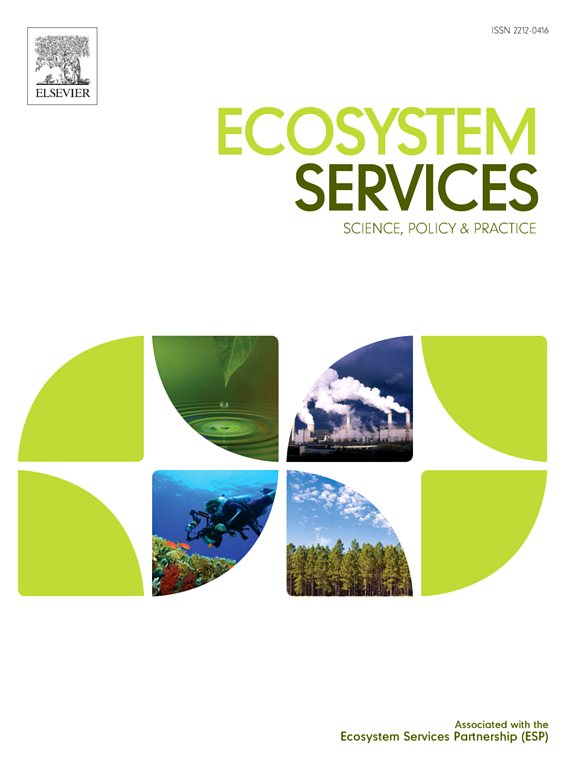The economic value of human-honeyguide mutualism in Reserva Especial do Niassa, Moçambique
IF 6.6
2区 环境科学与生态学
Q1 ECOLOGY
引用次数: 0
Abstract
People in many rural societies rely on wild birds for their livelihoods, often without benefiting the birds. A notable exception is the mutually beneficial relationship between humans and the greater honeyguide (Indicator indicator), a wax-eating bird that guides people to bees’ nests. Humans gain honey for food and income, while the birds feed on beeswax. Here, we estimated the economic value of honeyguides to honey-hunters in Moçambique’s Reserva Especial do Niassa (REN), where these birds regularly help locate wild honey. From interviews and community-collected data we estimated that, on average, honey-hunters sold 37 L[CI: 30, 44] of honey annually, earning $63[CI: 50, 76], and that three-quarters of the honey volume harvested was found with honeyguides. From these estimates we determined that an average Niassa honey-hunter earned $48 in 2018 (or $80 when applying 2023 prices) from selling 28 L of honey collected with honeyguides. With REN’s high poverty levels and low employment rates, these earnings are likely vital to household subsistence. Surveys by community wildlife guardians estimated ∼ 500 honey-hunters selling honey in REN, generating a total of $23,900 in 2018, or $40,700 when applying 2023 prices, from honey collected with honeyguides. Honey-hunting with honeyguides is a unique and dwindling cultural tradition that continues to thrive in REN, offering significant economic, livelihood and cultural benefits to rural communities living in miombo woodlands. Safeguarding these habitats and ensuring human access to them is imperative not only for their material benefits, but also to preserve this shared human heritage of partnership with wildlife. Please see AfricanHoneyguides.com/abstract-translations for a Portuguese translation of the abstract.
莫拉萨保护区人蜜共生的经济价值
许多农村社会的人们依靠野生鸟类维持生计,往往没有给鸟类带来好处。一个值得注意的例外是人类和大导蜜鸟(指示器指示器)之间的互利关系,这是一种以蜡为食的鸟,引导人们到蜜蜂的巢穴。人类获取蜂蜜作为食物和收入,而鸟类则以蜂蜡为食。在这里,我们估计了在moambique的reserve special do Niassa (REN)中,蜜䴕对采蜜者的经济价值,这些鸟经常帮助寻找野生蜂蜜。根据访谈和社区收集的数据,我们估计,平均而言,采蜜人每年出售37升[CI: 30,44]蜂蜜,赚取63美元[CI: 50,76],而采蜜量的四分之三是由蜜䴕发现的。根据这些估计,我们确定,2018年,一个尼萨采蜜人平均销售28升采蜜,收入48美元(按2023年的价格计算,平均收入80美元)。由于缅甸的高贫困率和低就业率,这些收入可能对家庭维持生计至关重要。社区野生动物守护者的调查估计,约有500名采蜜人在REN出售蜂蜜,2018年从采蜜向导收集的蜂蜜中获得了23,900美元的收入,按照2023年的价格计算,这一收入为40,700美元。与蜜䴕一起采蜜是一种独特的文化传统,它在REN继续蓬勃发展,为生活在miombo林地的农村社区提供了巨大的经济、生计和文化利益。保护这些栖息地并确保人类能够进入这些栖息地,不仅是为了它们的物质利益,也是为了保护人类与野生动物合作的共同遗产。请参阅AfricanHoneyguides.com/abstract-translations获取摘要的葡萄牙语翻译。
本文章由计算机程序翻译,如有差异,请以英文原文为准。
求助全文
约1分钟内获得全文
求助全文
来源期刊

Ecosystem Services
ECOLOGYENVIRONMENTAL SCIENCES&-ENVIRONMENTAL SCIENCES
CiteScore
14.90
自引率
7.90%
发文量
109
期刊介绍:
Ecosystem Services is an international, interdisciplinary journal that is associated with the Ecosystem Services Partnership (ESP). The journal is dedicated to exploring the science, policy, and practice related to ecosystem services, which are the various ways in which ecosystems contribute to human well-being, both directly and indirectly.
Ecosystem Services contributes to the broader goal of ensuring that the benefits of ecosystems are recognized, valued, and sustainably managed for the well-being of current and future generations. The journal serves as a platform for scholars, practitioners, policymakers, and other stakeholders to share their findings and insights, fostering collaboration and innovation in the field of ecosystem services.
 求助内容:
求助内容: 应助结果提醒方式:
应助结果提醒方式:


